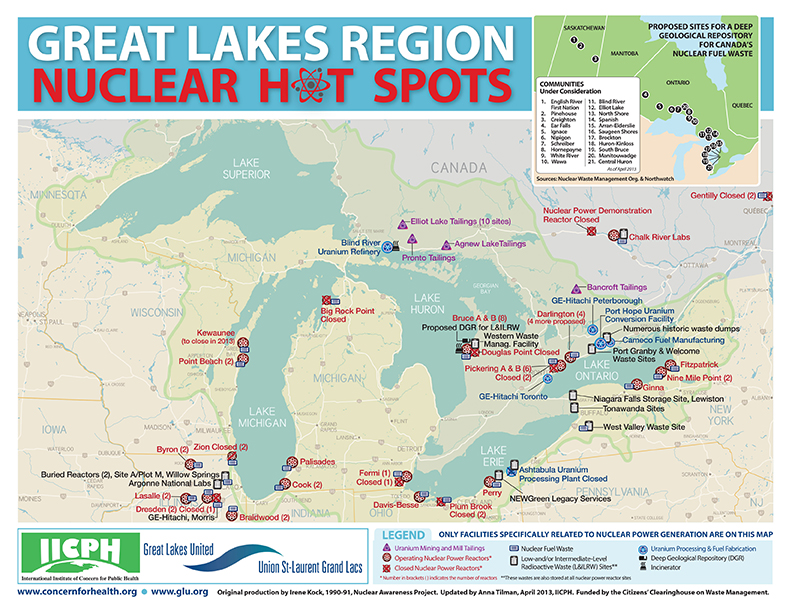(Originally published March 2, 2016 on https://athf3.wordpress.com/)
News from Beyond Nuclear and Canadian Environmental Law Association (CELA)
March 2, 2016 FOR IMMEDIATE RELEASE
Toronto, Ontario, Canada and Washington, D.C., U.S.A. – More than 100 organizations from around the Great Lakes are calling on the Canadian and American governments to list radionuclides as a “chemical of mutual concern” under the Great Lakes Water Quality Agreement. The groups’ call is supported by a new report outlining the shortcomings of current efforts to track radionuclides and explaining what needs to be done to properly monitor these dangerous substances in our Great Lakes.
“The Great Lakes basin is a hotbed for nuclear-related activity, withmore than 30 nuclear generating stations, fuel processing facilities, waste disposal and uranium mine tailing sites scattered around the four lower lakes,” points out John Jackson, author of the new report.

“We simply don’t know what the cumulative impact of these nuclear facilities and waste sites is on the lakes because there is no comprehensive monitoring of radionuclides in Great Lake waters,” says Theresa McClenaghan, Executive Director of the Canadian Environmental Law Association.
Meanwhile, the Canadian Nuclear Waste Management Organization (NWMO) continues to search for a long-term high-level radioactive waste disposal site, where highly radioactive fuel bundles from all of Canada`s nuclear facilities, including Ontario’s 20 commercial power reactors, would be permanently buried. Eight of the nine sites being considered by the NWMO are in the Great Lakes Basin.
“The evidence is that even very low levels of radiation can have serious health impacts, from cancer- causing cell damage to genetic mutations that can trigger birth defects,” says Kevin Kamps of Maryland-based Beyond Nuclear. In the U.S., the Biological Effects of Ionizing Radiation panel found that “there is no compelling evidence to indicate a dose threshold below which the risk of tumor induction is zero.”
As well as nuclear power production and its associated supply chain, there are also numerous medical facilities, universities and some industries located in the Great Lakes Basin that work with radioactive substances. On the U.S. side, weapons-related facilities are also potentially significant radionuclide contamination sources.
Concerns regarding radionuclides in the Great Lakes have long been an issue. The Nuclear Task Force of the International Joint Commission highlighted the inconsistency in reporting and monitoring of radionuclides in the Great Lakes basin as far back as 1997.
“What’s important to remember is that radioactive materials are constantly on the move around and across the Great Lakes. Whether it is fuel being shipped from a processing facility to power plants, waste being moved to storage sites, or tritium being shipped to a factory, these materials aren’t just sitting in one place,” says Jackson, adding “this opens up a real risk for accidental releases into the lakes themselves or into waterways that flow into the lakes.”
These movements will increase if the NWMO does develop a long-term storage site for used nuclear fuel. As of 2004, there was 36,000 tonnes of highly radioactive waste sitting in temporary storage at the province’s three nuclear plants. On the American side, there was an estimated 13,825 tonnes of irradiated fuel sitting at nuclear facilities in the Great Lakes basin as of 2011.
“We need to get a better handle on the impact of radionuclides on drinking water quality, fish and wildlife survival and the health of aquatic ecosystems throughout the Great Lakes. Radionuclides are not included in the most comprehensive environmental monitoring programs for the lakes because our governments have not listed them as a chemical of concern. That needs to change so that we start keeping better track of what all of this nuclear activity around the basin means for the health of our lakes and ourselves,” says McClenaghan.
The report is available at www.cela.ca/publications/radionuclides-chemical-mutual-concern-great-lakes-basin.
The groups’ submission is available athttp://www.cela.ca/publications/Letter-nomination-radionuclides-chemical-mutual-concern-GLWQA
For further information contact:
John Jackson
Report Author and CELA board member
Office: 519-744-7503
Cell: 519-591-7503
E-mail: jjackson@web.ca
Theresa McClenaghan
Executive Director
Canadian Environmental Law Association
Office: 416-960-2284 ext. 219
E-mail theresa@cela.ca
Kevin Kamps
Radioactive Waste Watchdog
Beyond Nuclear
Cell: 240-462-3216
E-mail: kevin@beyondnuclear.org
